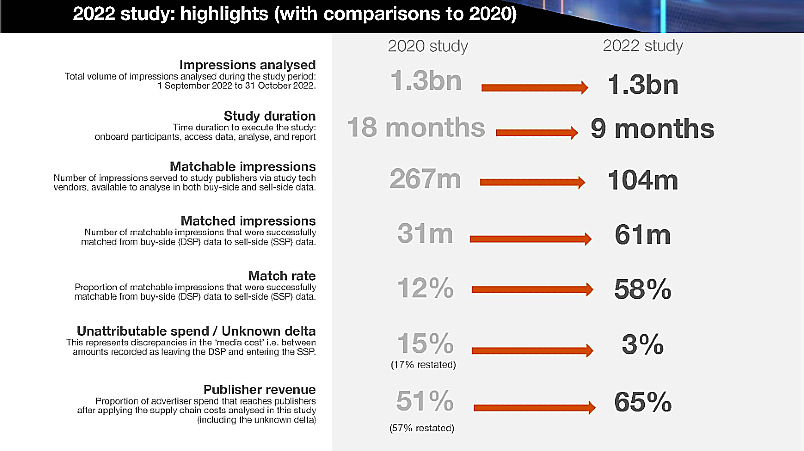‘Unknown delta’: Flagship programmatic transparency study shows more cash flowing to publishers, fewer missing dollars – but 96% of digital ad impressions still can’t be fully tracked

Publishers – at least at the top end of town – appear to be getting a bigger slice of marketers' programmatic ad dollars while advertisers seem to be getting more transparency. But as ISBA updates its groundbreaking programmatic supply chain transparency study – with brands including Diageo, Dominos, Pepsico and Vodafone – no one seems really satisfied. Unattributable revenue, the "unknown delta", fell from 15 percent to low single digit digits, but critics point out that the key players in the digital ad supply chain remain unable to match 96 percent of impressions end-to-end (yes, you read that right).
What you need to know:
- Unattributable ad spend drops from 15 per cent to 3 per cent, per ISBA study undertaken by PwC.
- Data sets standardisation, better access to log level files, and greater clarity around contractual issues improved data matching levels.
- Revenue flowing to publishers increases by 8 percentage points.
- Critics say study only reflects the best case scenario: As much as 96 per cent of impressions could not be matched end-to-end.
- ISBA: "We would not expect – currently – the rest of the market to reflect these results."
- Local adtech players and publishers think programmatic transparency unlikely to be solved without ACCC action - and a unique transaction ID.
Numbers game
The number of digital display dollars disappearing into the morass of the programmatic ad ecosystem has shrunk dramatically, at least in the world of top tier advertising and publishing.
The ground-breaking study in 2020 by ISBA in the UK found that 15 per cent advertising spend could not be attributed. However, that figure has now shrunk to just 3 per cent in the next iteration of the study, released last week. As Mi3 reported in 2020, the 15 per cent figure was an average and the actual range of unattributable spend ranged from 0 to 86 per cent, according to ad fraud specialist Augustine Fou who analysed the result. ISBA declined to provide the ranges for the second study when approached by Mi-3, citing confidentiality considerations.
The new research involved 11 advertisers, 7 agencies, 6 DSPs and 6 SSPs and 10 publishers, and analysed 1.3 billion impressions over 9 months. It provides what the ISBA described as 'positive and welcome improvements'.
The report's authors say there was a massive increase in ad impression match rates (essentially ‘matching’ the transaction on demand side platform with those on the supply side platform). The match rate grew from a parsimonious 12 per cent in 2020 to a passable 58 per cent in 2022. Furthermore, the study’s authors claim methodology and data quality improvements mean that there is now good reason to believe the unmatched impressions in this study would exhibit similar results to the matched ones, something they stressed was not the case in 2020.
Standardisation of data sets, access to log level files for all of the adtech vendors in the study, and greater clarity around contractual issues enabled the greater data matching levels, according to the study. These improvements also cut the time needed to complete the study in half: Access to data was one of the main challenges of the previous study, with significant head-scratching across the supply chain anecdotally reported.
Follow the money
For advertisers one key benefit is that unattributable ad spend (referred to as the "unknown delta") was reduced to 3 per cent (compared to 15 per cent* in 2020).
There is also good news for publishers, with the total proportion of ad dollars spent flowing into their accounts increasing by 8 percentage points to 65 per cent, suggesting premium publishers at least are now receiving a healthier share of advertiser budgets (the report's authors revised up the 2020 figure of 51 cents in the dollar arriving at publishers to 57 cents following a methodology change).
However, the improvements in transparency are not consistent.
“The industry needs to continue its collaboration to make financial audits a routine feature of the market,” according to the authors who also flagged a discernible difference in the missing delta between public and private marketplaces.
In the former, 3 per cent of the loot still goes missing, while in the later to number has sunk to just one per cent on average, according to the report's findings.
According to Eric Franchi, General Partner at New York-based AperiamVentures, which invests in early stage martech and adtech businesses, the rise of private marketplaces and curated markets contributed to the better result. He made the comments on Ari Paparo's Marketecture podcast shortly after the release of the report.
“All of this non-open exchange type of buying that we've seen over the course of the past few years can account for a 10 per cent change, a 10 per cent swing, a 10 per cent delta right there,” he suggested.
For his part, Paparo was skeptical about the results. "it is very questionable whether to attribute the data improvements to real changes in the business or to the study methodology."

Doubts remain
Paparo's skepticism is not an isolated response. While describing the latest iteration of the study as a great update, ad fraud researcher Augustine Fou took a different perspective on the match rates.
“Even though the ISBA focused on the increase in match rate — from 12 per cent in 2020 to 58 percent in 2022 — the reality is that the number of impressions matched from end-to-end went from 31 million to 61 million [of a total of 1.3bn impressions covered by the study].
"In absolute numbers, the percentage of impressions matched out of impressions analysed went from 2 per cent (31 million / 1.3 billion) in 2020 to 4 per cent (61 million / 1.3 billion) in 2022. As an advertiser and ad buyer, would you be satisfied with knowing only 4 per cent of what you bought could be successfully traced from end to end through the programmatic supply chain? Put another way, 96 per cent of the impressions could not be matched end-to-end."
Beauty pageant?
He also argued that the study reflects what he described as "well lit neighbourhoods" of programmatic advertising that may not be indicative of the wider landscape.
"This should be considered a best case scenario," said Fou. "I'm all for improvements, and we did improve from 2 per cent matched in 2020 to 4 per cent matched in 2022; but let's not kid ourselves that the programmatic supply chain is 'transparent'."
His views where echoed by James Bayes, ANZ boss at The Trade Desk, which is aiming to take custom from Google by trading on a transparency ticket.
“While it’s encouraging to see the proportion of advertiser spend reaching publishers go up, the Australian advertising industry still has a long way to go before we can call it ‘fair.’ The walled gardens like Google dominate the Australian ad market, taking 80 per cent of ad revenue and making it difficult for advertisers to see where their money is going or where ads end up. As a result, they struggle to measure and optimise their campaigns," said Bayes.
He said the walled garden's 80 per cent share of budgets is at odds with where audiences actually are - and cautioned against closing off the open web for other walled gardens. "Australians spend 76 per cent of their time online on the open internet," including BVOD and digital audio, per Bayes. "That presents a huge opportunity for advertisers, enabling them to drive greater transparency, objectivity and precision in their digital marketing campaigns.”
But others said that open marketplaces would remain murky without interventions such as the transaction ID, so impressions can be tracked from advertiser to eyeball, as proposed by the ACCC. Some of the dominant players are said to be resisting that approach, while IAB Australia is also reticent, citing potential privacy implications and pushing instead for industry to adopt transparency standards.
Per one publisher: "I don’t see how we completely resolve the opacity of OMP (open market places) without a unique transaction ID that can be audited end-to-end."
The ISBA itself acknowledged some of these concerns in comments about the reduction in the unknown delta from 15% to 3% this year to Mi-3.
According to a spokesperson, "It’s worth pointing out that this average was only possible with the excessive support provided to the ad tech vendors by PwC’s data science and programmatic specialists and therefore only relates to this particular study and its limited high end participants. We would not expect – currently – the rest of the market to reflect these results."
Standards
IAB Australia CEO Gai Le Roy said the study showed that industry is cleaning up its act – and getting its act together – in terms of ability and willingness to open up data across the chain, speaking the same language and adopting industry transparency standards. She said auditors becoming more familiar with the programmatic market is also a key factor in reporting meaningful progress.
Le Roi said PwC had recognised the importance of IAB standards such as ads.txt, but urged both buy-side and sell-side players locally to grasp the nettle in order to facilitate more transparent trading for advertisers of all sizes.
"We continue to urge the industry to follow the five-point plan published by IAB Australia in 2022 for increased transparency in programmatic trading," per Le Roi.
Australia's consumer and competition watchdog, the ACCC, has told the industry to better self-regulate on transparency, or face intervention. Le Roi has consistently urged industry to heed that warning.
See the ISBA report here.
*Due to changes in the methodology, ISBA has restated some of the 2020 results to allow for direct comparisons. For instance publisher revenue from 2020 was restated from 51 to 57 per cent and the unknown delta was revised up from 15 to 17 per cent in 2020.
